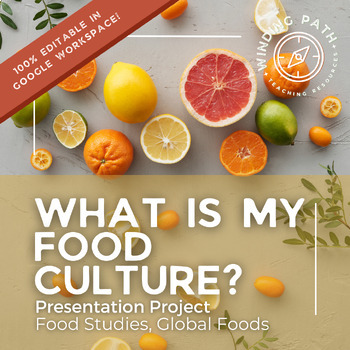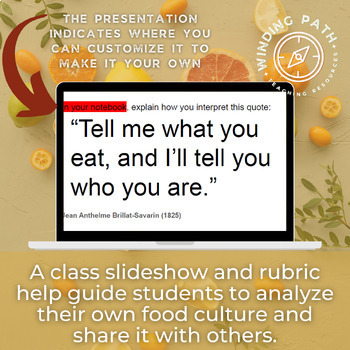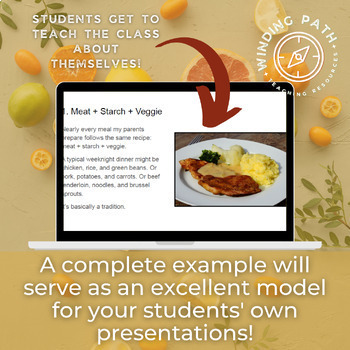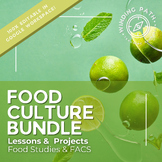My Food Culture Presentation Project | What is Food Culture Lesson
- Google Drive™ folder

Also included in
- Looking for a comprehensive exploration of the connections between culture and food, with informative examples from around the world and throughout history? You'll have a expert way to get students to answer "What is a food culture?" This bundle introduces students to food cultures in an interactivePrice $12.00Original Price $16.00Save $4.00
Description
In this engaging and personally relevant project, students will create a presentation that describes their food culture, whether they knew they had one or not! (They may be asking themselves, 'What is food culture?') But first, students will watch a TED Talk and read an article about American food cultures, and discuss both. Then they will explore 4 global food cultures (Morocco, India, Italy, and Sweden), record their observations, and work with a partner to figure out what makes each one unique. This will help them begin thinking about their own food culture based on what makes them, their family, and their community unique. This is a fantastic way to engage your students in the concept of food cultures and get them thinking globally with world cultures!
For my high school Food & Culture class, this is an early lesson I have planned in the year, because it gives the students an opportunity to get to know each other in a new way and explore the connections the course material has in their own lives and what is food culture in the first place. In addition, it's a great way to expand students' thinking to include world cultures, even in their own classroom.
The Value in Your Classroom:
- Easy preparation: Just print it or load it to your learning management system and you're ready to teach!
- 100% editable: Everything your students will see is editable in Google Workspace, so if you want, you can modify it to the specific needs of your students.
- Engagement: Students share their food cultures with each other and learn more about the rest of their classroom's learning community.
- Save Time: This lesson has materials from start to finish!
---------------------------------------------------------------------
Here's how the lesson is structured:
- Engagement: The lesson opens up with a TED Talk and an article about American food cultures, and what exactly constitutes 'American' food. The students will discuss amongst themselves what they think 'American' food is and what it isn't.
- Global Food Cultures Stations: Students will then examine 4 food cultures from around the world and record their observations about what makes each one unique. After exploring all of them, they will partner up and create a 6-word summary in which they explain how one food culture is unique.
- Project Introduction: The teacher will next introduce the project to students by first having the students interpret a quote. Then the teacher will give the students instructions and an overview of the project, along with a template for the students to use and a finished example to serve as a model.
- Presentation Creation and Sharing: Students will have a few days to create their own presentations about their own food culture. Halfway through, the students will share their progress with another student for peer-editing. Using the rubric provided by the teacher, students will give each other 2 comments with constructive criticism and 3 comments of praise. When they are finished, students will deliver their presentations to their classmates.
- Student Feedback: The teacher will give each student a note card and students will give each other feedback on what they learned from a classmate. This will help facilitate a positive classroom atmosphere!
---------------------------------------------------------------------
Here is what you get in this lesson:
- Full, detailed lesson plan (5 pages) with:
- Content Overview
- Lesson Objectives
- Assessments
- Suggested Lesson Procedure
- Materials List
- Differentiation and Extensions
- 4 carefully research stations of food cultures from around the world with copyright-free images and maps (editable in Google Docs)
- A editable Google Slideshow with links to learning resources, directions, project resources, and a finished example.
- A editable Google Document with project instructions, a structure for the presentation, and a rubric.
- A project template for students to help them complete their project (editable in Google Slides)
---------------------------------------------------------------------
Looking for more Food Studies material? Check out my Food Culture Exploration! Or my Food Memory Cookbook Mini-Unit:
- Introduction to Food Memories
- Food Memory Interviews
- Creating Your Recipes
- Constructing Your Cookbook
- **The Entire Food Memory Cookbook Mini-Unit Bundle**
Please let me know if you have any questions or concerns with this project, I'm happy to help! Please leave an honest review for this product, it helps both me and other teachers!
Thank you!!






